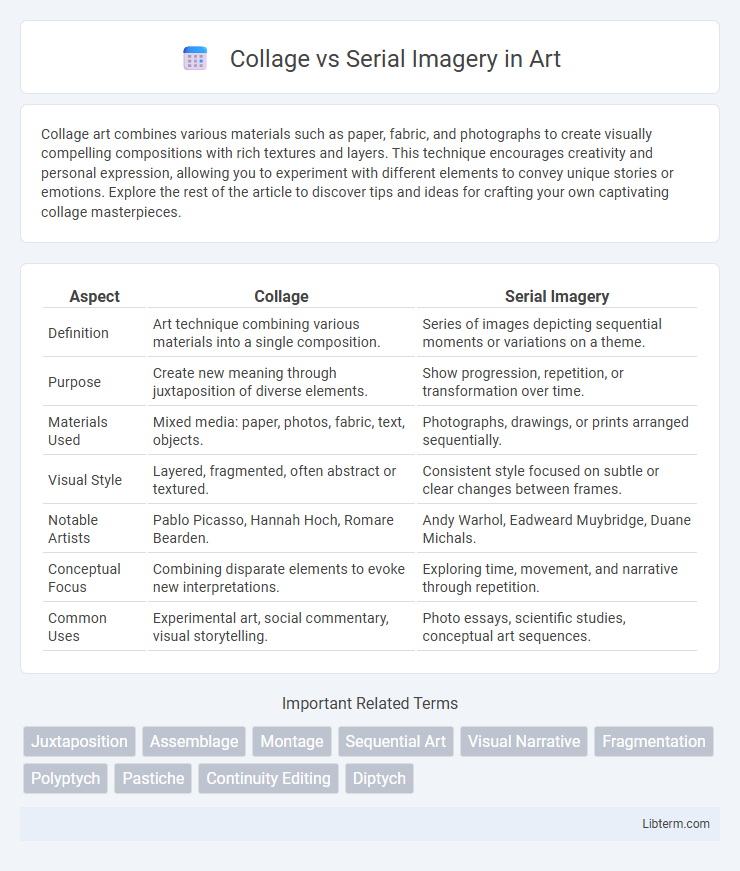Collage art combines various materials such as paper, fabric, and photographs to create visually compelling compositions with rich textures and layers. This technique encourages creativity and personal expression, allowing you to experiment with different elements to convey unique stories or emotions. Explore the rest of the article to discover tips and ideas for crafting your own captivating collage masterpieces.
Table of Comparison
| Aspect | Collage | Serial Imagery |
|---|---|---|
| Definition | Art technique combining various materials into a single composition. | Series of images depicting sequential moments or variations on a theme. |
| Purpose | Create new meaning through juxtaposition of diverse elements. | Show progression, repetition, or transformation over time. |
| Materials Used | Mixed media: paper, photos, fabric, text, objects. | Photographs, drawings, or prints arranged sequentially. |
| Visual Style | Layered, fragmented, often abstract or textured. | Consistent style focused on subtle or clear changes between frames. |
| Notable Artists | Pablo Picasso, Hannah Hoch, Romare Bearden. | Andy Warhol, Eadweard Muybridge, Duane Michals. |
| Conceptual Focus | Combining disparate elements to evoke new interpretations. | Exploring time, movement, and narrative through repetition. |
| Common Uses | Experimental art, social commentary, visual storytelling. | Photo essays, scientific studies, conceptual art sequences. |
Understanding Collage and Serial Imagery
Collage integrates diverse materials and images into a unified composition, emphasizing visual and conceptual contrasts to create multi-layered meaning. Serial imagery involves presenting a sequence of related images that explore variations in form, time, or narrative, highlighting progression and thematic development. Understanding collage requires recognizing how disparate elements interact within a single frame, while serial imagery demands attention to continuity and transformation across multiple frames.
Historical Origins of Collage
Collage originated in the early 20th century, pioneered by artists like Pablo Picasso and Georges Braque during the Cubist movement, who incorporated newspaper clippings and various materials into their paintings. This technique marked a significant departure from traditional artistic methods by combining disparate elements to create new visual narratives. In contrast, serial imagery developed as a way to capture multiple frames or moments sequentially, primarily influenced by advancements in photography and film.
Evolution of Serial Imagery
The evolution of serial imagery highlights its role in capturing sequential actions or moments, contrasting with collage's assemblage of disparate visual elements into a single frame. Early serial imagery, pioneered by Eadweard Muybridge, documented motion through multiple frames, influencing modern multimedia and art forms that emphasize temporal progression. This development underscores serial imagery's function in visual storytelling and scientific study, expanding beyond static composition inherent in collage techniques.
Key Techniques in Collage Art
Collage art primarily uses key techniques such as layering different materials, combining textures, and integrating found objects to create visually dynamic compositions. Artists employ cutting, tearing, and pasting to assemble diverse elements like photographs, paper, fabric, and paint, enhancing depth and contrast within the artwork. These methods distinguish collage from serial imagery, which focuses on repetition and sequential visual narratives rather than material integration.
Methods and Approaches in Serial Imagery
Serial imagery employs sequential visual frames to convey progression or transformation, utilizing repetition and variation to explore narrative or conceptual development. Techniques include alternating perspectives, gradual changes in composition, and thematic continuity that emphasize temporal or emotional shifts within the series. Unlike collage, which combines disparate elements into a single static image, serial imagery relies on the deliberate arrangement and evolution of related images to create meaning over time.
Visual Language: Comparing Aesthetic Qualities
Collage employs fragmented visual elements that create a layered aesthetic, enhancing depth through juxtaposition and contrast, while serial imagery relies on sequential frames to convey narrative progression and temporal continuity. The collage's visual language emphasizes associative meaning and sensory richness by merging diverse textures and perspectives, whereas serial imagery prioritizes rhythm, repetition, and visual coherence to guide viewer interpretation over time. Both techniques expand artistic expression but differ fundamentally in how they engage spatial versus temporal dimensions of visual communication.
Narrative Possibilities: Storytelling in Collage vs Serial Imagery
Collage offers dynamic narrative possibilities by layering diverse images and materials to create complex, multi-dimensional stories through juxtaposition and symbolism. Serial imagery builds narrative through sequential frames, emphasizing temporal progression and causality, guiding viewers step-by-step through a story. Both techniques exploit visual language, but collage invites interpretive depth while serial imagery ensures clarity in storytelling progression.
Cultural Influences and Artistic Movements
Collage, emerging prominently in early 20th-century Dada and Cubist movements, reflects cultural influences by integrating diverse materials and images to challenge traditional art forms and question societal norms. Serial imagery, heavily associated with Pop Art and artists like Andy Warhol, explores repetition and mass production themes, mirroring consumer culture and media saturation. Both techniques reveal shifts in artistic practices driven by evolving cultural landscapes and the interrogation of visual representation.
Contemporary Applications and Trends
Contemporary applications of collage emphasize mixed media techniques that integrate digital and traditional materials, fostering experimental visual narratives in art, advertising, and fashion design. Serial imagery trends leverage repetition and variation through digital algorithms and animation to explore temporal progression and conceptual storytelling in modern photography and graphic design. Both practices reflect evolving technological tools and cultural dialogues, driving innovation in visual communication and interdisciplinary collaborations.
Choosing Between Collage and Serial Imagery
Choosing between collage and serial imagery depends on the artistic goal and narrative complexity desired. Collage offers a dynamic, layered composition by combining diverse materials and textures, perfect for conveying fragmented, multifaceted stories. Serial imagery emphasizes sequential visual storytelling, ideal for exploring changes over time or detailed progressions within a consistent theme.
Collage Infographic

 libterm.com
libterm.com